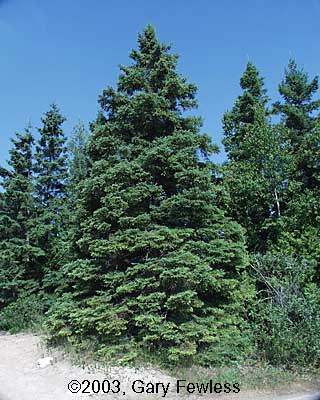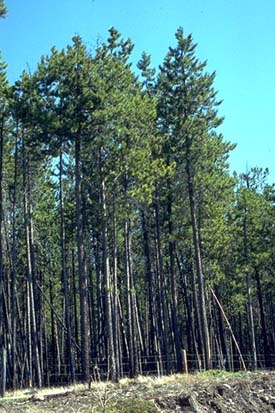Tree species
White spruce (Picea glauca)
 White spruce stands Source: University of Wisconsin |
The USDA Forest Service website summarizes and synthesizes research about living organism, and provides a thorough database on tree species. The following information on white spruce is from the Fire Effects Information System web page. White spruce is a native, coniferous, evergreen tree. White spruce wood is light, straight-grained, and resilient. It is an important commercial tree harvested primarily for pulpwood and lumber for general construction.
White spruce seeds are nutritious and are a good energy source for small mammals (i.e. red squirrels, snowshoe hares, mice, voles, shrews, and chipmunks) and birds (i.e. chickadees, nuthatches, crossbills, and the pine siskin) White spruce also provides good wildlife cover.
The following critical attributes of white spruce, as researched by the Forest Service, were taken into consideration:
- It is not recommended for planting on steep slopes subject to erosion.
- It is largely confined to well-drained uplands or river terraces and floodplains.
- There are found on stream bottoms, river terraces and lake margins, and on warm, well-drained, south-facing slopes within 5 miles (8 km) of major river valleys (in interior Alaska and the Northwest Territories).
- Seral stands of white spruce are common on relatively dry slopes with a south or southwest exposure, and on dry, excessively drained outwash or deltaic soils.
- At arctic timberline, white spruce grows in well-drained soils, often along streams where permafrost has been melted away by flowing water.
- In British Columbia and Alberta, white spruce is widely distributed, occupying floodplains, foothills, and mountains from 2,500 to 5,000 feet (762-1,524 m) in elevation.
- White spruce grows on a wide variety of soils of glacial, lacustrine, marine, or alluvial origin. It grows well on loams, silt loams, and clays, but rather poorly on sandy soils.
Lodgepole pine (Pinus contorta)
 Lodgepole pine stands Source: Domtar |
The following information on lodgepole pine is also from the Fire Effects Information System web page. Lodgepole pine is an ubiquitous species with a wide ecological amplitude. Lodgepole pine is not only an important timber species but is also a major tree cover in many scenic and recreational areas and on critical watersheds. It provides many acres of wildlife habitat and is associated with many grazing allotments throughout its range. Lodgepole pine is used for framing, paneling, posts, corral poles, utility poles, railroad ties, and pulpwood.
The following critical attributes of lodgepole pine, as researched by the Forest Service, were taken into consideration:
- Lodgepole is very intolerant of shade and generally grows best in full sunlight.
- Lodgepole pine grows on soils that vary widely but are usually moist.
- It grows best where soil parent materials are granites, shales, and coarse-grained lavas.
- In Canada, extensive stands occur on calcareous glacial tills.
- The coastal form of lodgepole pine (var. contorta) is often found on peat bogs (in southeastern Alaska, British Columbia, and western Washington), and on dry, sandy, or gravelly sites.
- Extensive stands are found, in central Oregon, on well drained sites above 1600 m (5,250 ft)
- Lodgepole pine thrives in a wide variety of topographic situations. It grows well on gentle slopes and in basins, but good stands are also found on rough and rocky terrain and on steep slopes and ridges, including bare gravel.
- Northern and eastern slopes are more favorable than southern and western aspects